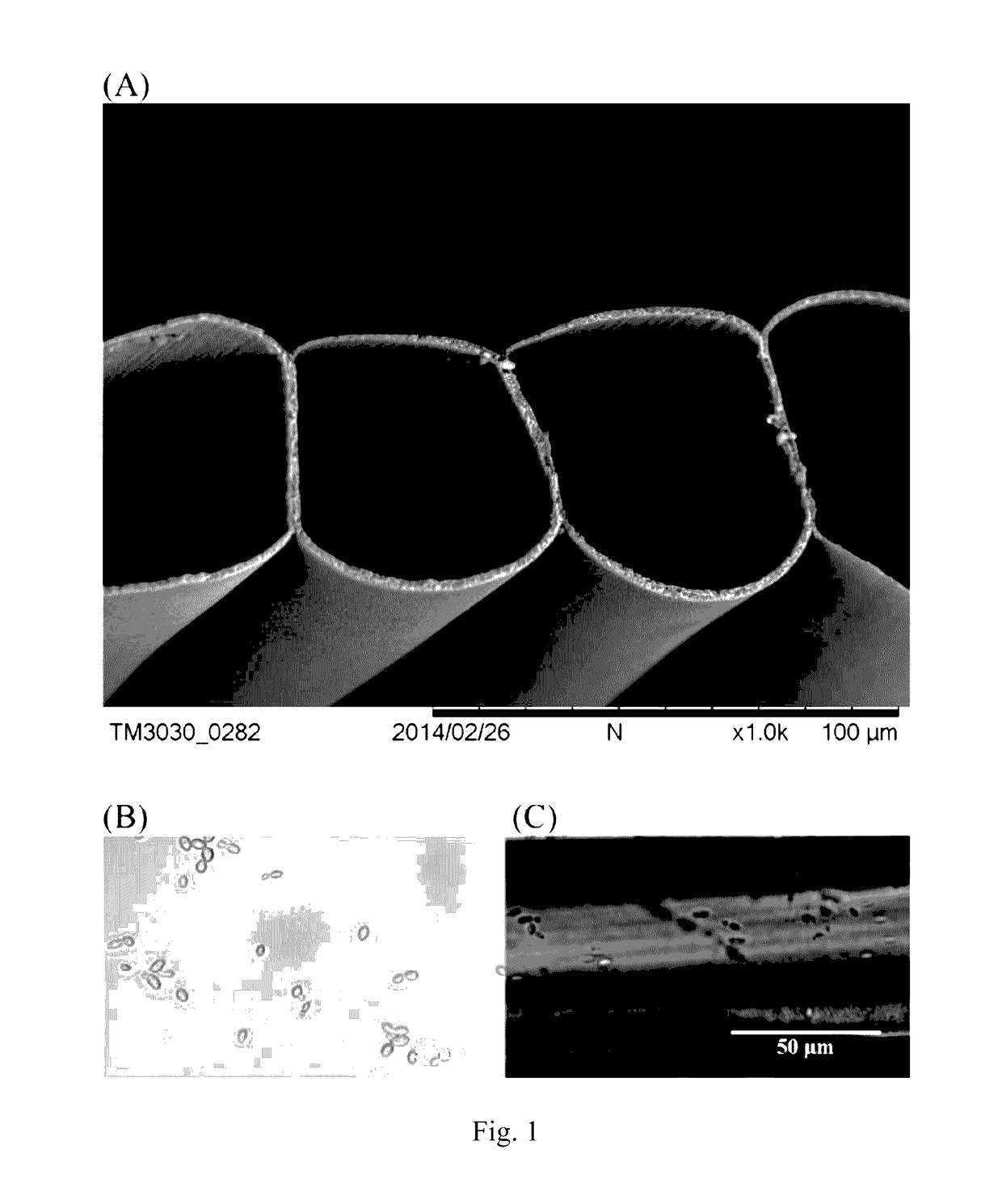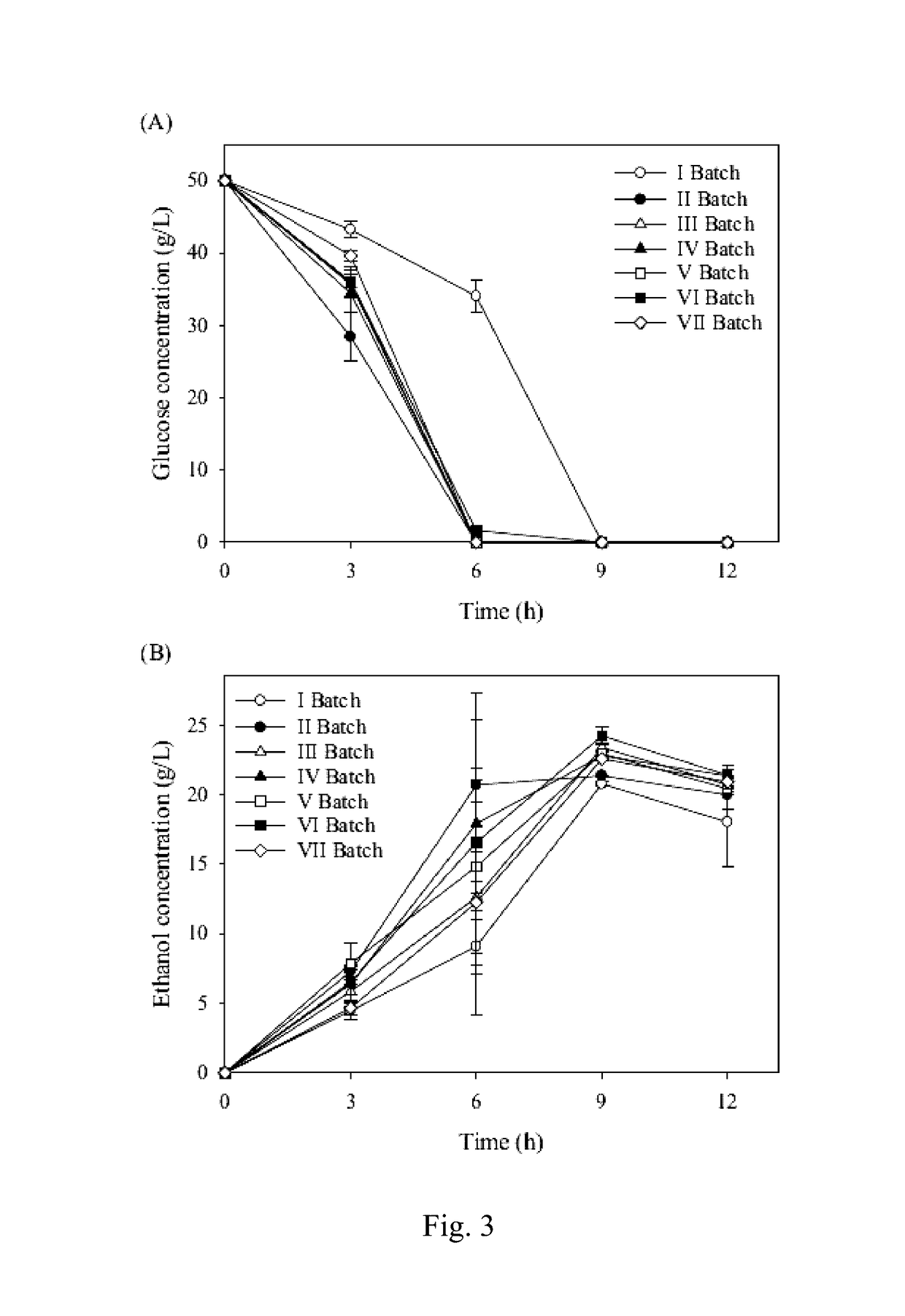Poly-l-lactic acid (PLLA) microtube array membrane-immobilized yeast cells for bioethanol fermentation
a microtube array and yeast cell technology, applied in biofuels, biochemical equipment and processes, enzymes, etc., can solve problems such as the stability of gel-immobilized yeasts, and achieve the effect of high stability and yield and yeast encapsulation efficiency
- Summary
- Abstract
- Description
- Claims
- Application Information
AI Technical Summary
Benefits of technology
Problems solved by technology
Method used
Image
Examples
example 1
Encapsulation of K. marxianus in PLLA MTAM
[0052]The scanning electron microscope (SEM) section image of MTAM is shown in FIG. 1(a). MTAM consists of a single layer of hollow tubes with a diameter of approximately 40 μm and a hollow tube wall pore diameter of approximately 30 nm. Free K. marxianus cells and MTAM-immobilized K. marxianus cells are shown in FIG. 1(b) and (c). PLLA-MTAM entrapped the yeast cells for immobilization to obtain high biomass loadings in fermentation. Enantiomerically, pure PLLA is a semicrystalline polymer with a glass transition temperature of approximately 55° C. and a melting point of approximately 180° C. (Prog. Polym. Sci. 27 (2002) 1123-1163), suggesting that PLLA-MTAM is thermostable at all known bioethanol fermentation temperatures. Furthermore, PLLA is insoluble in water and its solubility in solvents is highly dependent on the molar mass and degree of crystallinity (Prog. Polym. Sci. 27 (2002) 1123-1163).
example 2
Effects of Ethanol and Agitation on the Stability of MTAM
[0053]To determine the effect of agitation and ethanol, MTAM-immobilized K. marxianus was incubated at different rpm settings and ethanol concentrations. As shown in Table 1, MTAM retained a consistent solidity at 3%, 6%, 9%, 12%, and 15% (v / v) ethanol for more than 5 weeks (840 h) (data not shown). Our data indicated that MTAM was stable at 15% (v / v) ethanol for more than 840 h and that cell immobilization may be applicable for repeated-batch and continuous feEtnentations. The effect of agitation (100, 200, 300, 400, and 500 rpm) on MTAM was determined using 2 different methods, a rotary shaker and a fermenter with an impeller. As shown in Table 1, MTAM started to tear at an incubation time of 72-96 h on a rotary shaker at an rpm of 200. As the rpm was decreased, the time required for any tear to appear on MTAM was increased. At the rpm settings of 50 and 100, MTAM showed no tearing within 600 h (25 days). MTAM showed no obvi...
example 3
Effects of Encapsulation Methods and Cell Numbers on Encapsulation Efficiency
[0054]We evaluated the encapsulation efficiency of yeast K. marxianus for 2 encapsulation methods, in situ and siphon preparations. As shown in Table 2, encapsulation of 108 yeast cells using the in situ and siphon methods showed encapsulation efficiencies of 70.0±2.0% and 67.0±15.0%, respectively. The 2 methods showed similar encapsulation efficiencies at a cell density of 108. our encapsulation efficiency data suggested that the K. marxianus cells survived the process of electrospinning.
TABLE 2The effects of encapsulation methods andcell numbers on encapsulation efficiency.Encapsulation efficiency (%)Cell numbers (CFU / mL)In situ preparationSiphone10870 ± 2.0%67 ± 15.0%Data are expressed as mean ± SD (n = 3).
PUM
 Login to View More
Login to View More Abstract
Description
Claims
Application Information
 Login to View More
Login to View More - R&D
- Intellectual Property
- Life Sciences
- Materials
- Tech Scout
- Unparalleled Data Quality
- Higher Quality Content
- 60% Fewer Hallucinations
Browse by: Latest US Patents, China's latest patents, Technical Efficacy Thesaurus, Application Domain, Technology Topic, Popular Technical Reports.
© 2025 PatSnap. All rights reserved.Legal|Privacy policy|Modern Slavery Act Transparency Statement|Sitemap|About US| Contact US: help@patsnap.com



